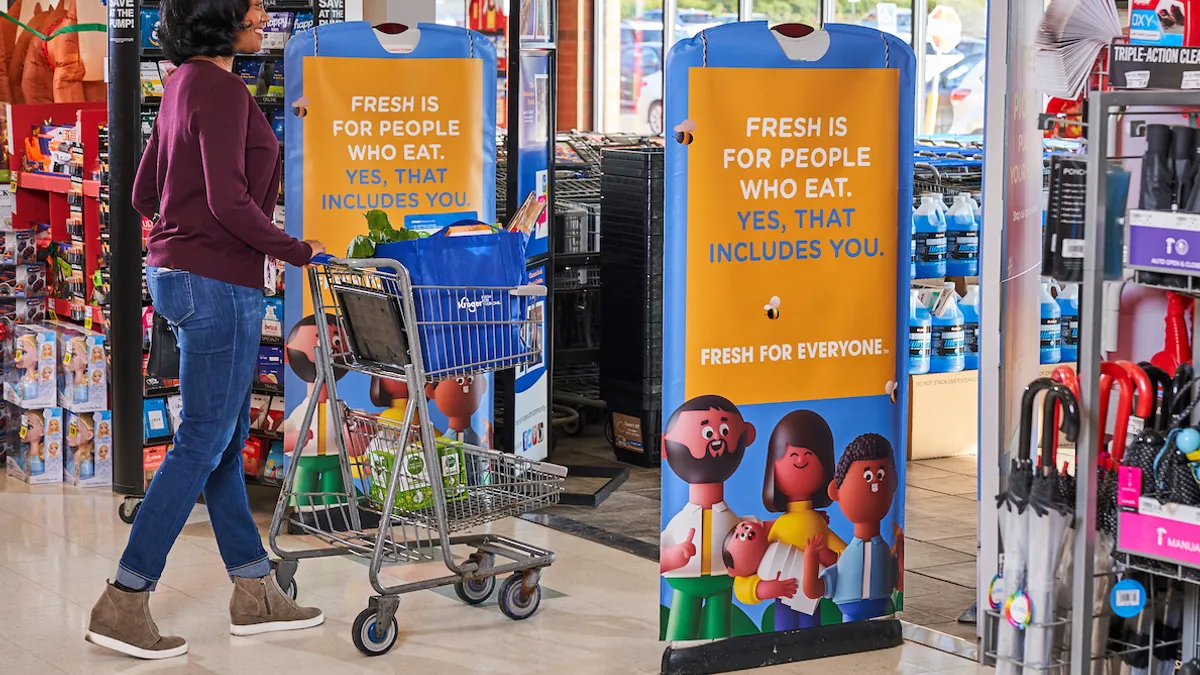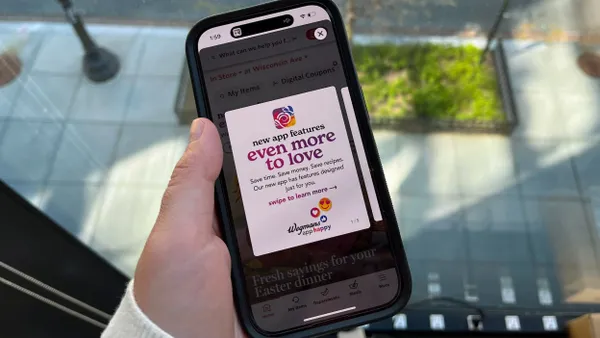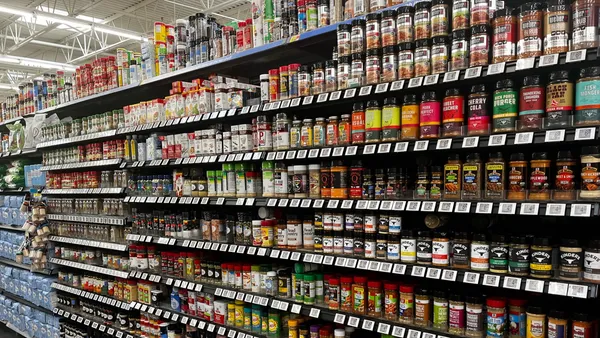Don’t worry, we’ve got this.
That was the message Kroger conveyed Tuesday at its annual investors conference in New York. The grocer’s Restock plan, which has come under scrutiny in recent months amid tepid quarterly results and evolving competitive challenges, is starting to pay off and will accelerate growth in the months ahead, company officials said — albeit later than anticipated.
Kroger reaffirmed its financial guidance for 2019 and forecast additional growth for 2020. It expects same-store sales excluding fuel next year to be higher than 2.25% and adjusted earnings per share to fall in the range of $2.30 to $2.40, ahead of the $2.19 outlined by Wall Street before the event.
"The time it took to get momentum into (Restock) took longer than we expected," said CEO Rodney McMullen, who noted the company "is more confident than ever" in the wide-ranging plan first announced two years ago.
The news sent the company’s stock soaring 11%, indicating investors may finally be ready to line up behind Restock, as well.
Still, the investment community has called on Kroger to provide more transparency into its long-term strategy. Kroger acknowledged this, first by holding the investors conference in New York rather than at its Cincinnati headquarters, and second by spending three hours outlining the ways they’re fine-tuning Restock, which broadly focuses on leveraging its core grocery business for margin-rich, asset-light alternative investments. Those alternative investments are expected to bring in $150 million in incremental profit next year, up from $100 million this year.
The presentation highlighted what the company has done well and where it hasn’t lived up to expectations. It was a detailed and optimistic look at the ongoing strategy, but not everyone is sold on its long-term viability.
'Kroger is food-first'
Kroger’s core grocery business has come under significant pressure as competitors innovate and offer lower pricing, leaving industry observers wondering how the nation’s largest conventional grocer will forge ahead.
Part of the answer is in continuing to hit on initiatives that are paying off, officials said. This includes private label, which now accounts for close to a third of Kroger’s overall sales. Simple Truth and Private Selection, the company’s most successful brands that collectively account for more than 3,000 products, will continue to expand. Simple Truth Plant-Based, the company’s newest store brand, will see 58 additions next year, said Joe Grieshaber, Kroger’s senior vice president of merchandising.
Kroger will also continue to leverage what executives call its leading data science capabilities to roll out more personalized offers. More than 10 million Kroger customers utilize fuel points, said Grieshaber, and many of them cite that as the main reason for shopping with the company. Expanding point multipliers and special offers will be a priority, he said, as will extending the reach of targeted digital offers.
Kroger is also banking on a new look and marketing campaign to boost its grocery business. "Fresh for Everyone," the company’s new tagline, recognizes research that shows the company leads among top grocery chains when it comes to perception of quality among perishables, officials said. It also acknowledges meat, seafood, meals and produce as leading determiners of where consumers grocery shop.
"Unlike our national competitors, Kroger is food-first," said McMullen.
Not all has gone according to plan, however. Kroger’s space optimization program, which seeks to merchandise products for maximum impact, has been slow to roll out and needs to be improved, McMullen said. Kroger’s pharmacy business has also struggled with profitability — an industry-wide trend, McMullen noted, but one that can be mitigated by improving the efficiency of filling prescriptions.
Kroger officials also acknowledged they were a bit overzealous at the outset of Restock Kroger, front-loading the strategy when they should have spaced out initiatives over time.
"We asked our stores to do too much at the same time," McMullen said.
Being 'flexible' with digital
The investment community was anxiously awaiting an update on Kroger’s Ocado strategy, which is still in the early stages but seems in peril of being outmaneuvered by an army of micro-fulfillment centers. At least one leading financial firm has called the grocers’ focus on large, automated centers "a misstep," saying each shed could take about four years to turn a profit and return limited market share gains.
On Tuesday, Yael Cosset, Kroger’s chief information and digital officer, stressed the partnership has more "flexibility" built into it than industry observers realize. He said the company and Ocado will utilize small, medium and large facilities to fill orders according to market demands. This includes pickup as well as delivery, and orders ranging from on-demand to next-day and beyond.
Cosset did not offer any details on what those facilities might look like.
"It is not going to be one size satisfies all the demand," he said. "Our solution, our focus is to really balance those points closest to the customer, which is our stores, all the way up to larger facilities and everything in between."
Those larger facilities, projected to cost around $50 million each, are proving more expensive to build than the company anticipated. Gary Millerchip, Kroger’s chief financial officer, said the cost of land has gone up since Ocado began building its facilities, while rising labor costs have contributed to a higher price tag for construction.
By the end of the year, Kroger will offer same-day delivery as well as pickup from more than 2,000 stores each. That footprint will reach the vast majority of its customers, but Kroger is still in an arms race to compete on e-commerce promotions and services. Amazon last week announced it would make its Fresh delivery service free to all Prime members, in addition to its free two-hour delivery from Whole Foods stores. Walmart on Tuesday rolled out "unlimited" grocery delivery to 1,400 stores — a complementary service to its free grocery pickup, which will touch 3,000 locations by the end of this year.
In response, Kroger announced Tuesday it will waive its fee for grocery pickup — normally $4.95 — in select markets through the holidays. The company will closely monitor customer response to the offer. Cosset said he anticipates fulfillment efficiencies achieved through Ocado’s facilities will also bring down consumer fees in the years ahead.
Both Kroger and Ocado have been testing expedited delivery. In Cincinnati, Kroger has been testing a 30-minute service called Rush, while Ocado’s micro-fulfillment solution, Zoom, debuted earlier this year in London. Cosset said Ocado is extending its innovation pipeline to Kroger as the two companies deepen their partnership.
"There’s this assumption that Ocado has only one model because they have optimized their (delivery) model in a market like the U.K.," he said. "That is not the approach we have been taking with Ocado in the U.S. and definitely not [the] innovation they have brought to the table since day one. It is really about developing the optimized network based on the demand we see and that we see in the future."
Does Kroger need 'a more radical plan'?
Kroger’s improved profitability outlook for its alternative investments boosted investor confidence. The key growth streams, Kroger Personal Finance and Kroger Precision Marketing, will expand and evolve in the months ahead. Financial technology, or fintech, has upended traditional banking and asset management, and Kroger plans to add more products in this sector in addition to its credit cards, mortgages and other financial products.
"You’ve all seen what’s happening in fintech, and it’s a huge opportunity for Kroger," said Stuart Aitken, Kroger’s senior vice president of alternative business.
Meanwhile, Kroger’s marketing service hopes to capitalize on the ongoing disruption in CPG by selling insights and data products based on its own store and digital transactions. Cara Pratt, vice president of commercial and product strategy for Kroger Precision Marketing, pointed to the increasing flow of CPG trade dollars online, with $12.8 billion in anticipated spending by 2020, according to eMarketer, a 35% jump from 2018.
Kroger officials pointed to several tests and future opportunities, from growing fresh produce inside stores to leveraging its pharmacies to capitalize on the food-as-medicine movement. The company will scale promising opportunities that feed the symbiotic relationship it has tried to establish between its food and its alternative investments.
Kroger’s optimistic outlook and financial guidance provided a much-needed shot in the arm. But not everyone is rosy on the grocers’ outlook. Analysts with R5 Capital wrote in a note Tuesday that Kroger could have outlined a "more radical plan" in light of the competitive pressures it is facing in pricing, e-commerce and other areas. They called the company’s improvements "mediocre" given the strength of the economy.
"We see large historical businesses/profit pools under threat including pharmacy, gasoline, vendor funds, fresh and private label," the note read. "At the same time, we view omnichannel growth and the company's Ocado partnership, in combination with Amazon's relentless pursuit of the in-home consumables market and Walmart's omnichannel asset advantage given its supercenters, as likely to suppress volumes and profits. We simply could not view the world much (more) differently than the Kroger team."
Similarly, analysts with Jefferies called the presentation "uneventful" and said they were "challenged" to reach the same earning conclusion as Kroger, given pressures on its grocery business. The analysts also noted that, while they appreciated the company's plan to take a flexible approach to e-commerce fulfillment, the plan was lacking specifics and the higher-than-expected construction costs were concerning.
"We're still left [with] more questions than answers," the firm wrote in a note to clients.





















